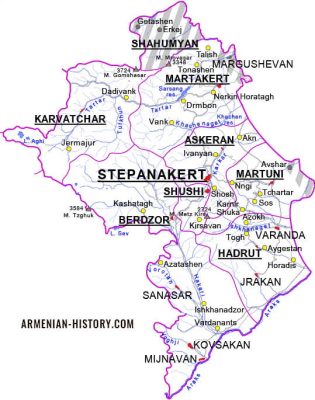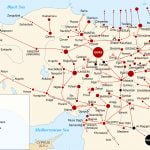Artsakh (Karabakh) Chronicle – Chronology
Artsakh Chronicle (February 1988 – May 1994) – The List of the most important events
February 12, 1988 – Nagorno-Karabakh people gathered at the first mass rally demanding reunification with Armenia. In 1992, Nagorno-Karabakh Republic’s Supreme Council declared February 12 the Day of Revival.
February 20, 1988 – Nagorno-Karabakh regional parliament decided to secede from Azerbaijan and rejoin Armenia. The first rally in support of Artsakh was staged in Yerevan.
February 22, 1988 – Azerbaijani militants from Aghdam assaulted Karabakh’s village of Askeran, but faced strong resistance from Armenian side.
February 27, 1988 – Armenian pogroms aimed at quelling Artsakh movement started in Sumgait, Azerbaijan, and raged from February 27 to 29. Hundreds of Armenians were slain (official report said 32), thousands wounded and 18000 driven from their homes.
February 28, 1988 – Soviet Union’s Supreme Council voided the Nagorno Karabakh’s landmark decision to rejoin Armenia.
November 21, 1988 – Armenian pogroms broke out in Kirovabad, the second biggest Armenians-dominated city after Baku, and raged until the end of the month.
November 25, 1988 – Gorbachov’s administration imposed curfew in Yerevan and Baku.
July 26, 1989 – local parliament of Shahumyan, Northern Artsakh, decided to rejoin Nagorno Karabakh.
October 1, 1989 – Pargev Bishop Martirosyan, Armenian Apostolic Church Artsakh Diocese’s leader, served the first mass.
December 1, 1989 – Armenian Soviet Republic’s and Nagorno-Karabakh Autonomous Region’s parliaments decided at a joint session to make Nagorno Karabakh a part of Armenia.
January 12, 1990 – Azerbaijani militants attacked Manashid village, but faced strong resistance.
January 13, 1990 – Baku’s 200 000 Armenians underwent violence and displaced. The outrages lasted until January 19.
January 15, 1990 – Armenian guerrillas took Kyarki, an Azerbaijani village of strategic significance, after a two-day battle.
Janury 18, 1990 – Nagorno-Karabakh Autonomous Region’s Supreme Council adopted the Declaration of Nagorno-Karabakh Republic’s Independence.
January 18, 1990 – Armenians and Azerbaijanis started exchanging military strikes. A fierce battle near Yeraskh ended in Armenian militiamen’s sweeping victory over the Azerbaijani militants who attacked the village in an attempt to seize it.
February 27, 1990 – Armenian Kond, Tigran the Great, Armenian Self-determination Union and Jermuk militia groups along with local guerillas launched a pre-emptive attack from Vayk province’s village of Bardzruni. The attack was resulted in Azerbaijani Qyarmanchatakh village seizure in Nakhijevan and elimination of the five-time-greater foe’s forces.
May 27, 1990 – 27 Armenian militiamen and civilians were killed in a clash with soviet soldiers in Yerevan Railway Station and Nubarashen crossroad.
September 20, 1990 – Special Regiment was created. This regiment consisting of 26 platoons from Yerevan and provinces constituted the pivot of future Armenian regular army. The regiment consisted of 2300. Its toll was estimated to be 159.
May 4, 1991 – Government-affiliated Defense Committee was set up.
July 15, 1991 – Air strikes and ground offensives launched by Soviet-Azerbaijani joint forces (Kirovabad’s division N230 resulted in Erkez village seizure. 72 attackers lost their lives and three armored vehicles were captured by Armenians. Manashid and Byuzlukh villages were ceded a day earlier.
August 16, 1991 – Responding to soviet army outrages, women of Parandzem group in Artsakh’s village of Haterk (Martakert) captured 43 soldiers with their armament, including armored vehicles, and kept them hostage for five days.
September 2, 1991 – Karabakh’s and Shahumyan’s councils declared Nagorno-Karabakh Republic creation at their joint session.
September 13, 1991 – Armenian troops launched counter offensive in Shahumyan province and ridded three villages – Erkez, Byuzlukh and Manashid – of enemies.
September 21, 1998 – Armenia conducted an independence referendum. Over 99% of the country’s population cast their votes for independence.
September 23, 1991 – Armenian Parliament, grounding on the referendum results, declared Armenia’s independence.
October 16, 1991 – Presidential elections were held in Armenia. Levon Ter-Petrosyan became the first president.
October 17, 1991 – Azerbaijanis launched air strikes on Nagorno-Karabakh city of Martuni and surrounding areas.
October 30, 1991 – Artsakh’s newly created armed forces headed by Arkady Ter-Tadevosyan liberated the foes’ stronghold –Yal village in Hadrut province.
November 20, 1991 – MI-8 military helicopter crashed en route from Aghdam to Martuni. Russian, Kazakh and Azerbaijani 21 troops and civilian high-ranking officials were killed in the crash.
November 26, 1991 – Azerbaijan’s Supreme Council voided Nagorno-Karabakh Republic declaration. This decision escalated tension.
December 4, 1991 – Armenian President Levon Ter-Petrosyan signed the law on government composition. Under this law, Defense Ministry was established along with other ministries.
December 10, 1991 – Nagorno-Karabakh Republic held an independence referendum. More than 99% of the republic’s population supported independence at the referendum.
December 10, 1991 – Tigran the Great unit’s 13-member group crushed 450-soldier garrison in Shahumyan province’s Todan village.
December 21, 1991 – Soviet army’s remaining units withdrew from Nagorno-Karabakh Republic’s territory.
January 6, 1992 – Nagorno-Karabakh Republic’s Supreme Council, taking into account the results of the independence referendum, declared the republic an independent state.
January 11, 1992 – Nagorno-Karabakh armed forces took two Azerbaijani strongholds – Malibeyli and Ghushchilar – by launching counter offensive.
January 20, 1992 – After two-day battles (Jan 20, 21) Artsakh’s forces liberated Stepanakert’s Krkzhan suburb.
Jnauary 26, 1992 – Azerbaijani troops suffered defeat near Karitak village (1km far from Shushi) after 12-hour bloody combat.
January 28, 1992 – The first unit – 1st Paratrooper Regiment of Armenian army was formed (1st paratrooper brigade was formed on September 14, 1992 and 1 artillery brigade on March 26, 1993). The unite was deployed in Ararat-Vayk border area. The unit took part in battles for Martakert and Kelbajar in 1994. Its death toll was 61 between 1992 and 1994.
January 28, 1992 – Armenian Defense Ministry was established in the country on Supreme Council Chairman’s order. Vazgen Sargsyan was appointed to the post of defense minister. Later, the defense ministerial seat was handed over to Vazgen Manukyan, Vagharshak Harutyunyan and Serge Sargsyan.
February 16, 1992 – Azerbaijani Grad and Uragan reactive stations launched rockets against Stepanakert. Armenians sustained heavy losses and material damage.
February 26, 1992 – Nagorno-Karabakh armed forces Karadaghlu Azewrbaijanis’ stronghold in Martuni.
February 26, 1992 – Nagorno-Karabakh troops launched an offensive against Khojalu, the second important strategic spot in Nagorno Karabakh after Shushi. The offensive ended in the city seizure.
March 2, 1992 – Armenia obtained UN membership.
March 22, 1992 – Armenian 1st regiment paratroopers were sworn in.
March 29, 1992 – Azerbaijanis assaulted Stepanakert from Shushi, Ghaibalu and Janhasan but booted out after a fierce battle.
April 29, 1992 – Artsakh defense forces pushed back Azerbaijani attackers from Stepanakert and Karintak.
May 8 – Artsakh’s troops stormed and liberated Shushi.
May 10, 1992 – Armenian armed forces established its first communication unit.
May 18, 1992 – Artsakh’s forces opened a corridor connecting Nagorno Karabakh with Armenia by liberating Kashatakh and Lachin (Berdzor).
May 1992 – Air Defense units formation was completed. May’s third Sunday is marked as the Day of Air Defense Forces.
June 13, 1992 – Soviet-Azeri joint forces launched assaults on Shahumyan and some parts of Martakert region.
June 1992 – Armenian armed forces completed an aviation unit formation. June 3 is marked in Armenia as Aviation Day.
July 4, 1992 – Under strong pressure of Azerbaijani forces and mercenaries from Turkey, Armenians withdrew from Martakert. Later a part of Tartar was left as well.
August 5, 1992 – 106 civilians were killed in missile strike against Stepanakert.
August, 1992 – Artsvashen fell after five days of fierce battles (August 4 to 8).
August 30, 1992 –A platoon called Eagles started operating. The platoon plaid a crucial part in Artsakh’s north-eastern frontline.
September 7, 1992 – The first engineering unit was formed in Armenian army. September 7 is marked as Engineering Troops Day.
October 2, 1992 – Armenian troops liberated a major part of the areas occupied by Azerbaijani forces two years ago.
October 4, 1992 – Azerbaijanis’ attempt to seize Lachin corridor was foiled by Armenians.
October 8, 1992 – Tank division formation was over in Armenian army. October 8 was declared to be the Day of Tank Troops.
October 10, 1992 – Armenian armed forces placed on record chemical unit formation completion. From 1996, October 10 is marked as Chemical Troops Day.
October 13, 1992 – Artsakh State University was founded by Nagorno-Karabakh and Armenian governments’ joint efforts. The university opening ceremony took place on May 10, a day after Shushi liberation first anniversary celebration.
October 19, 1992 – Missile units were formed. October 19 is Missile Troops Day in Armenia.
November 5, 1992 – Intelligence unit was created in Armenia. Later, November 5 was declared the Day of Intelligence Troops.
November 10, 1992 – Artsakh defense forces liberated Vaghuhas, Harutyunagomer, Kchoghut and Chldran villages in a six-day offensive. Earlier, in June and July Azerbaijanis took these villages.
November 17, 1992 – Military hospital opened. Later, November 17 was announced Military Doctors Day.
November 29, 1992 – Nagorno-Karabakh Republic’s army took four villages – Hayi Bazar, Luliduz, Ghuzlu and Gharajanli.
March 25, 1993 – Nagorno-Karabakh army launched an operation aimed at Kelbajar liberation (Karvachar) to open 2000-square km link between Nagorno Karabakh and Armenia. Hundreds of ancient buildings were saved. Dadivank built in IV to XIII centuries was among them.
April 1, 1993 – Kelbajar was liberated in a fierce counter offensive.
June 28, 1993 –Martakert taken by the foe right one year ago and six surrounding villages were liberated in two-day combats.
July 23, 1993 – Resisting the fore’s attacks, Artsakh’s army liberated Aghdam.
July 26, 1993 – Armenian President signed laws on instituting National Hero, Courage and Service in Battle medals. National Hero title has been awarded to 8, Courage medal has been given to 746 and Service in Battle medal to 339 people as of December 31, 2000.
August 18, 1993 – Azerbaijani air forces conducted a bomb attack against Kapan, The bombing destroyed large areas of the city.
August 22, 1993 – Nagorno-Karabakh army took Fizuli in a counter offensive. The enemy’s troops escaped from Kubatlu, Zangelan and Jebrail regions within following 10 days.
December 18, 1993 – 60 000 Azerbaijani troops with 1500 Afghan Mojaheds and other mercenaries launched a large-scale offensive to the full extent of Artsakh frontline. In two-month fierce battles (until March 1994) Armenians booted out the foe from the areas they assaulted.
January 7, 1994 – After three-day bloody combats, Azerbaijani troops and Afghan Mojaheds fighting together against Armenians managed to take back Horadiz, a remote southern spot of strategic significance though sustaining heavy losses.
April 9, 1994 – Nagorno-Karabakh army’s last military campaign ended in Martakert region’s north-eastern territory liberation.
April 22, 1994 – Armenian president signed the law on instituting First-Degree Battle Cross and Second-Degree Battle Cross. As of December 31, 2000, First-Degree Cross was awarded to 47 and Second-Degree Cross to 114 people.
May 12, 1994 – A cease-fire deal brokered by Russia and OSCE Minsk Group was signed by Armenian, Azerbaijani and Nagorno-Karabakh foreign ministers.





